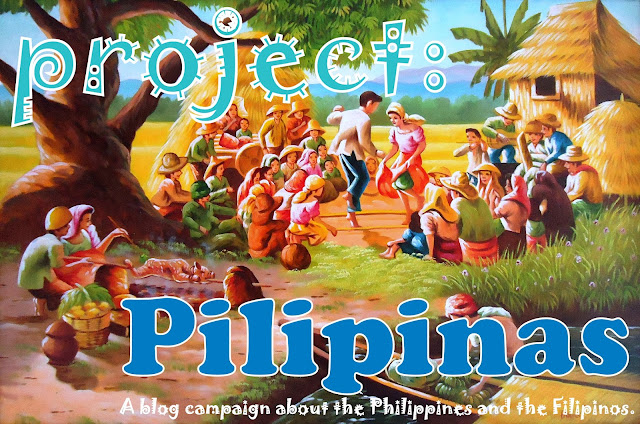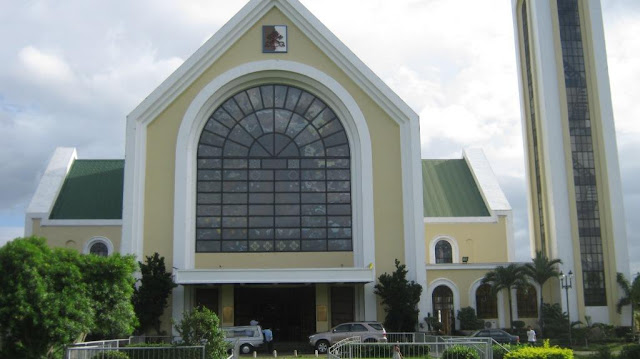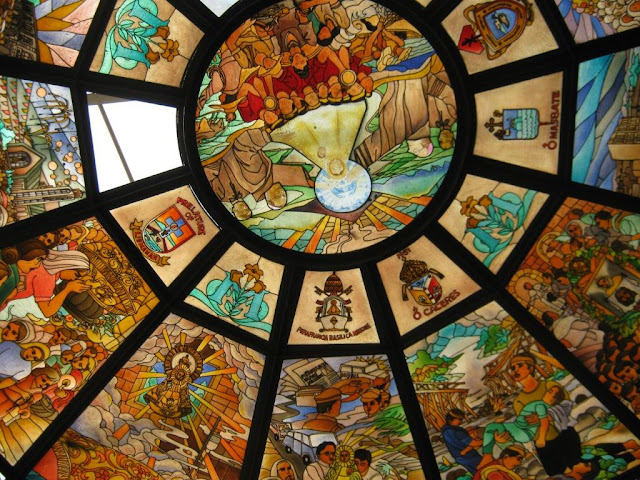If you are a Catholic, you might have been noticing those stained-glass windows from inside and outside the church. Typically, stained-glasses are the different colors of glasses in that window, ceiling, doors, and altar. What an art, right? Well, if you look closer, there are images of Jesus Christ’s life and sometimes that story of how the church or cathedral was built in the locality. And, aren’t they beautiful?
When I visited Singapore and Malaysia, I visited some of the worship houses there of our Buddhist and Hindu brothers and sisters. That Chinese culture of burning papers and incense, it is quite unique and seeing them doing these made me understand a little bit more of Buddhism. All I can say is that, if it’s about the architecture of their worship buildings, they are really beautiful in many ways.
Then I became fascinated with how Judaism works. Many of us probably knows the sad stories of the Jews during World War I. And that the Philippines was one of the countries who welcomed refugees trying to escape the Holocaust. I tried looking deeper into their religion by watching videos and reading a website that explains Judaism. Judaism as a religion is beautiful.
I have Filipino and foreign friends whom are Born Again Christian, Protestant, and Buddhist. The religion doesn’t matter if its about conversation of how life has been. And this is something that puzzles me, on why religion doesn’t matter at all when we talk about our life as human beings living in this planet. I met Muslims selling stuff on the markets near my place. I meet Buddhists in China Town. I talked to Hindus living in India. That respect of belief always prevails, and while there might be differences in prayers and rituals, it all goes well if it’s about friendship at work and neighborhood in the community.
Going back to the stained-glasses, I believe these were chosen to be components of the Catholic church’s architecture for a more meaningful reason. We church-goers may have been appreciating the design or beauty but in some ways, do we really know what are they for? Does it invite us to get to know more something about our faith in God?
Based on my research, stained-glass windows have been there since the 1100’s. Installed mostly on Cathedrals, the glass art actually have two main purposes: first is to add interior and exterior beauty and second is to serve as an educational tool. When beams of sunlight pass thru the colored window, the colorful reflection delights worshipers in beauty. The windows showing scenes in the Bible is a visual aid in teaching children and learners alike. That is the beauty of Catholicism.
This kind of art and the arts seen on different worship buildings of many religions remind us that faith of humanity in God or the Creator is characterized with beauty, style and elegance. It is quite obvious that whether it is Hinduism, Judaism, Catholicism, Christianity, or Islam, the worship buildings are built with amazing architecture and wonderful artistry – our ways as humans to show our deepest and sincerest respect to the God we believe in.
I am a Filipino Catholic by religion, direct to God by faith, but deep inside of me is that highest respect to all religions. It is just timely that the Christian world is celebrating the Christmas season when I wrote this post and the symbolisms of Christ’s coming can be seen almost everywhere. Decorations, lanterns, lights, and images are found on streets, homes, shopping malls, churches, vehicles, and buildings.
I believe that people of any kind of faith also have this kind of beauty they want to share to people outside their faith’s foundation. If stained-glasses are from the Catholic cathedrals, maybe the beautiful carpets inside the Mosque, wall paintings in the Buddhist temple, the art and images in a Hindu temple, and even the angelic voices inside a Christian’s holy place; these are the beauty of other religions and regardless of faith, we have the senses to appreciate them when we travel and been to these sacred worship places. And that is beautiful.
Christmas, like the stained-glass, is about beauty of Christianity. It is a celebration of faith and at the same time a sign of sharing the beauty inside a Christian’s heart to anyone regardless of race, culture, belief, or religion. When Muslims celebrate Ramadan, we respect the beauty they want to enshrine upon us. When the Chinese New Year is here, a festival celebrated around the world, we are delighted with how they pay respect to their Gods and Goddesses.
The intention of this post is not to promote Catholicism or speak against other religions. I believe every religion has a beauty in it, specifically, with the building structures be it a temple, synagogue, mosque, kingdom hall, worship place, house of worship, or whatever the religious organization calls it. And when it comes to beauty, nothing compares to the beauty of the fact that people believes in the existence of God.
Although I don’t have images of other religion’s worship places to share, what I really want to share in this post is the fact that there is something beautiful in believing in God.
Let me begin by sharing my short experience talking with certain non-Catholic people distributing free magazines in the street of the Philippines. They are the Jehova’s Witnesses. I am not to discuss what their religion is about for I know you can instantly search it online. My experience with them is that I used to ask copies of their reading materials and try to figure out what are written in there. Plainly speaking, they encourage us to know God and that is beautiful.
About a decade ago, when I first visited Baguio City in the Philippines, I was handed by several booklets by our Muslim brothers. Truth is, I have not read them for several years until I got this time and courage to open those books. The books explain how the Islam as a religion works, what they believe into, and simply state – they encourage us to believe in God they call Allah. And that is beautiful.
Then I happen to read the entire Christian bible or holy scripture just a few years back. I realized that many religions use this book. Then I become interested in understanding the beliefs of other religions by watching videos online, exploring websites, and asking questions to friends who have different religions than mine. I would say, there is no problem or even regret in making an effort to understand what others believe in. And if its about reading the Bible, there is absolutely a beauty in doing it. I learned, so to speak.
Although I don’t have images of other religion’s worship places to share, what I really want to share in this post is the fact that there is something beautiful in believing in God.
Let me begin by sharing my short experience talking with certain non-Catholic people distributing free magazines in the street of the Philippines. They are the Jehova’s Witnesses. I am not to discuss what their religion is about for I know you can instantly search it online. My experience with them is that I used to ask copies of their reading materials and try to figure out what are written in there. Plainly speaking, they encourage us to know God and that is beautiful.
About a decade ago, when I first visited Baguio City in the Philippines, I was handed by several booklets by our Muslim brothers. Truth is, I have not read them for several years until I got this time and courage to open those books. The books explain how the Islam as a religion works, what they believe into, and simply state – they encourage us to believe in God they call Allah. And that is beautiful.
Then I happen to read the entire Christian bible or holy scripture just a few years back. I realized that many religions use this book. Then I become interested in understanding the beliefs of other religions by watching videos online, exploring websites, and asking questions to friends who have different religions than mine. I would say, there is no problem or even regret in making an effort to understand what others believe in. And if its about reading the Bible, there is absolutely a beauty in doing it. I learned, so to speak.
When I visited Singapore and Malaysia, I visited some of the worship houses there of our Buddhist and Hindu brothers and sisters. That Chinese culture of burning papers and incense, it is quite unique and seeing them doing these made me understand a little bit more of Buddhism. All I can say is that, if it’s about the architecture of their worship buildings, they are really beautiful in many ways.
Then I became fascinated with how Judaism works. Many of us probably knows the sad stories of the Jews during World War I. And that the Philippines was one of the countries who welcomed refugees trying to escape the Holocaust. I tried looking deeper into their religion by watching videos and reading a website that explains Judaism. Judaism as a religion is beautiful.
I have Filipino and foreign friends whom are Born Again Christian, Protestant, and Buddhist. The religion doesn’t matter if its about conversation of how life has been. And this is something that puzzles me, on why religion doesn’t matter at all when we talk about our life as human beings living in this planet. I met Muslims selling stuff on the markets near my place. I meet Buddhists in China Town. I talked to Hindus living in India. That respect of belief always prevails, and while there might be differences in prayers and rituals, it all goes well if it’s about friendship at work and neighborhood in the community.
Going back to the stained-glasses, I believe these were chosen to be components of the Catholic church’s architecture for a more meaningful reason. We church-goers may have been appreciating the design or beauty but in some ways, do we really know what are they for? Does it invite us to get to know more something about our faith in God?
Based on my research, stained-glass windows have been there since the 1100’s. Installed mostly on Cathedrals, the glass art actually have two main purposes: first is to add interior and exterior beauty and second is to serve as an educational tool. When beams of sunlight pass thru the colored window, the colorful reflection delights worshipers in beauty. The windows showing scenes in the Bible is a visual aid in teaching children and learners alike. That is the beauty of Catholicism.
This kind of art and the arts seen on different worship buildings of many religions remind us that faith of humanity in God or the Creator is characterized with beauty, style and elegance. It is quite obvious that whether it is Hinduism, Judaism, Catholicism, Christianity, or Islam, the worship buildings are built with amazing architecture and wonderful artistry – our ways as humans to show our deepest and sincerest respect to the God we believe in.
I am a Filipino Catholic by religion, direct to God by faith, but deep inside of me is that highest respect to all religions. It is just timely that the Christian world is celebrating the Christmas season when I wrote this post and the symbolisms of Christ’s coming can be seen almost everywhere. Decorations, lanterns, lights, and images are found on streets, homes, shopping malls, churches, vehicles, and buildings.
But the stained-glass windows are always there and whenever I entered our worship buildings here in the Philippines, those colorful glasses reminds me that I have a God who allows beauty to shine upon me, His believer.
I believe that people of any kind of faith also have this kind of beauty they want to share to people outside their faith’s foundation. If stained-glasses are from the Catholic cathedrals, maybe the beautiful carpets inside the Mosque, wall paintings in the Buddhist temple, the art and images in a Hindu temple, and even the angelic voices inside a Christian’s holy place; these are the beauty of other religions and regardless of faith, we have the senses to appreciate them when we travel and been to these sacred worship places. And that is beautiful.
Christmas, like the stained-glass, is about beauty of Christianity. It is a celebration of faith and at the same time a sign of sharing the beauty inside a Christian’s heart to anyone regardless of race, culture, belief, or religion. When Muslims celebrate Ramadan, we respect the beauty they want to enshrine upon us. When the Chinese New Year is here, a festival celebrated around the world, we are delighted with how they pay respect to their Gods and Goddesses.
May this post serve as an inspiration to many of us, whatever our religion might be, to see the beauty in faith rather than show hatred in others’ beliefs. Religions should not divide us. Instead, it should be a way to exchange good ideas about life, that in our differences, there is something beautiful that we can learn from each other. Respect others belief and they will respect you back. Like me, you can always look at your religion’s versions of the stained-glasses and see the beauty in it.
About this Post
About this Post
I wrote this post as a gesture of saying "Merry Christmas" to all. 2017 has been very challenging for me and my wife yet we managed to survive. My faith in God really works. Somehow, those pains and sorrows were alleviated. Somehow, with prayers, good things still comes in. Whatever is your foundation of faith, keep in trusting your God. That will definitely make a big difference in your life.
This would be final blog for this year. Thanks for reading my posts. See you next year for more meaningful blog articles in this website and on my educational website, www.knowriel.com. God bless us all in the coming year 2018!






















Comments
Post a Comment